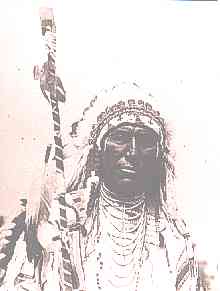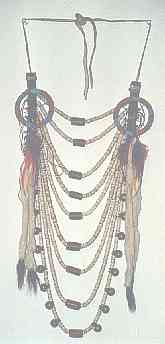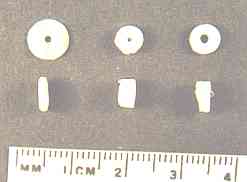The Bead SiteHome>Beadmaking & Materials>Organic Materials> Shell Disc Beads
Shell Disc Beads in Northwest America
by Scott M. Thompson
Most of us are familiar with the important role beads played (and still play) in the decorative arts of Native Americans. One bead type often overlooked by scholars is the shell disk bead of Northwest America.
|
||||||
From where did all of these beads come?
Ethnohistoric sources tell of Native California people (the Pomo, Miwok, Yurok, Maidu, and others) using and making strings of clam shell disk beads for personal adornment and as a medium of exchange.2 Knowing their use by California people, some writers automatically assumed that these were the beads used by Plateau and western Plains people for loop necklace manufacture.3
However, I'm not convinced of this. In areas even nearer to the coast than the territory of the Crow or Blackfeet, those beads were said to be valuable, "a double handful of the coast beads was equal in value to a large tanned buckskin or a horse."4
Yet Native informants and vintage photographs attest that loop necklaces were very common. In spite of the notion that the necklaces symbolized wealth and social standing any man - rich or not - who wanted to advertise his regional affiliation could apparently obtain the necessary materials.
Moreover, direct trade between California Natives and the Columbia Plateau had ended before the loop necklace became a popular ornament. When trade did exist between them, few shell disk beads seem to have been traded. Archaeological artifacts recovered from the Great Basin and the Columbia Plateau include nowhere near the quantity of beads needed for even one loop necklace,5
|
Richard Conn credits the Campbell company for the manufacture, "By the 1880s, most such beads were made commercially at the Campbell Wampum factory in New Jersey,"7
In another source (see footnote 5) there is no mention of discoidal shell beads made by Campbell, only cylindrical and tubular ones.
Published inventories of traders and trading companies focus on the fur trade years, predating the use of loop necklaces by a decade or more. They do not list shell disk beads as trading stock.
So the question remains, from where did all these beads come? Maybe a reader of TheBeadSitewill be able to provide additional information. Opinions are interesting but documented evidence on the origins of shell disk beads submitted here could broaden our understanding of Native American aesthetics and of Indian-white trade relations.
FOOTNOTES
1 Some sources imply that bone disk beads were an acceptable alternative to shell beads for loop necklace construction. Of the 276 loop necklace samples using disk beads included in my 2001 survey of this style of ornament, only one was positively identified as being made of bone disk beads.
2 See Alfred Kroeber, Handbook of the Indians of California, (New York: Alfred A. Knopf, 1931). Andrew H. Whiteford, North American Indian Arts, (New York: Golden Press, 1970). Page 134 shows a concise diagram of Native manufacture of shell disk beads.
3 Two examples include a caption on a loop necklace in the Pamplin exhibit of Native Arts (Lewis Clark Center for Art and History, Lewiston , ID, Summer 2000) and Evelyn Wolfson's American Indian Tools and Ornaments, (New York: David McKay, 1981), p. 21.
4 Verne F. Ray, The Sanpoil and Nespelem, (Seattle: University of Washington Press Publications in Anthropology, v. 5, n. 2, 1933), p. 48.
5 See Donald Collier and others, Archaeology of the Upper Columbia Region, (Seattle, University of Washington Press Publications in Anthropology, v. 9, n. 1, 1942), pp. 92-97 as one example.
6 Charles E. Hanson, Jr. "Campbell Wampum," Museum of the Fur Trade Quarterly, (v. 21, n. 4), pp 2-6.
7 Richard Conn, A Persistent Vision, (Denver: Denver Art Museum, n.d.), p. 110.
© 2002 Scott M. Thompson
__________________________________________________
Small Bead Businesses | Beading & Beadwork | Ancient Beads | Trade Beads
Beadmaking & Materials | Bead Uses | Researching Beads | Beads and People
Center for Bead Research | Book Store | Free Store | Bead Bazaar
Shopping Mall | The Bead Auction | Galleries | People | Events
The Bead Site Home | Chat Line | Contact Us | Site Search Engine | FAQ


